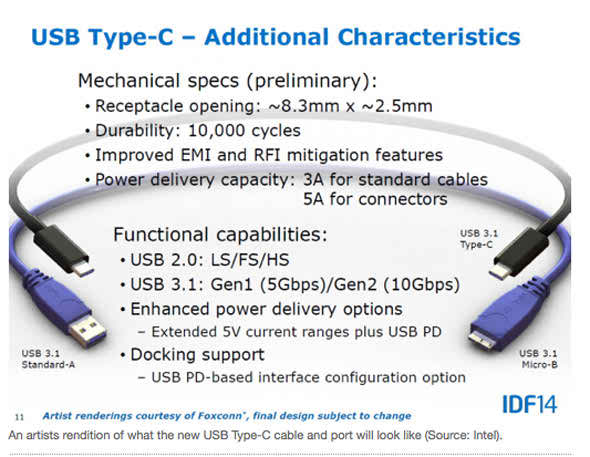USB Implementers Forum says final USB 3.1 specification will be published in July
The redesigned USB connector, belonging to the USB 3.1 specification, could be in laptops and mobile devices by the end of the year.
The appealing advances in the USB 3.1 technology include faster data transfer speeds and the user-friendly Type C connector, which connect to devices on either end. Since users won’t have to worry about plug orientation, they should be less likely to have trouble fitting cables into slots, which will be an improvement over USB connectors.
USB 3.1 also boosts data-transfer speeds and cables will ultimately be able to move data at a speed of 10Gbps (bits per second). That’s an improvement from the 5Gbps transfer rate for the current USB 3.0 connector, which is in most laptops that ship today. The faster speeds open usage of USB 3.1 connectors to monitors, high-definition TVs and other electronics.
MORE ON NETWORK WORLD: 13 awesome and scary things in near Earth space
The connector is “robust enough for laptops and tablets; slim enough for mobile phones,” said standards-setting organization USB Implementers Forum in an email statement. The Type-C connectors could replace the current micro-USB 2.0 ports in most of the latest smartphones and tablets, which have different ends and are widely used for recharging.
The Type-C USB 3.1 connector is as thin as micro-USB 2.0 connectors, which could also lead to the development of thinner and sleeker devices. Current USB 3.0 ports in laptops are larger, so thinner slots could lead to smaller products. The USB 3.1 connector will also replace micro-USB 3.0 plugs, which are larger and used in just a handful of devices such as the Samsung Galaxy Note 3.
The USB 3.1 specification is scheduled to be completed in July and products may be out by the end of the year, a USB-IF spokeswoman said in an email Wednesday.
The new cables will not work on existing USB ports, so the USB-IF is developing separate cables so existing products can connect to products with USB 3.1 ports. Users will have to purchase new devices to take advantage of end-to-end USB 3.1 connections.
USB 3.1 will be slower than Thunderbolt 2.0 connector technology, which is used in computers and peripherals, and can transfer data at 20Gbps. But USB has many advantages over Thunderbolt, including cheaper costs and a wide installation base. Peripherals based on Thunderbolt, which supports PCI-Express and DisplayPort protocols, are still priced at a premium.
Intel, which is leading Thunderbolt development and supports USB, has dismissed the idea of competition between both protocols. Intel has even suggested that USB could be technically used in the same wires alongside Thunderbolt, but that hasn’t happened yet.
USB-IF is talking up the new specification at the Intel Developer Forum this week in Shenzhen, China.
Best comptia A+ Training, Comptia A+ Certification at Certkingdom.com

No Comment